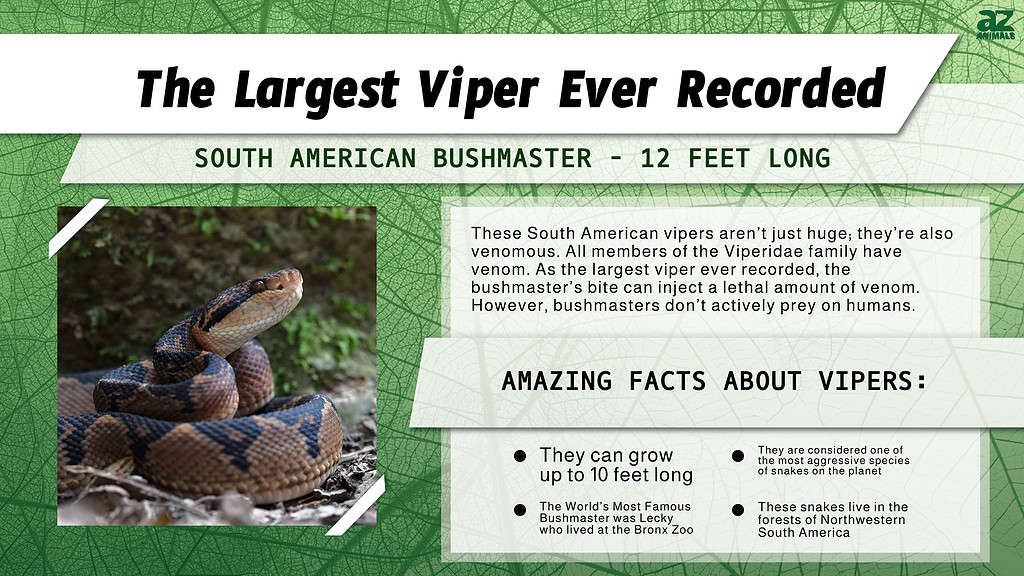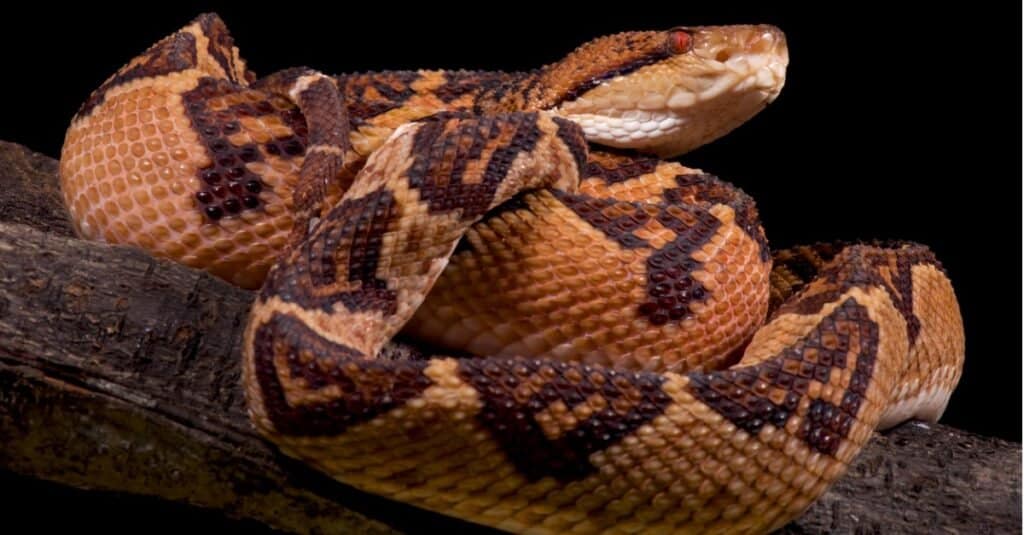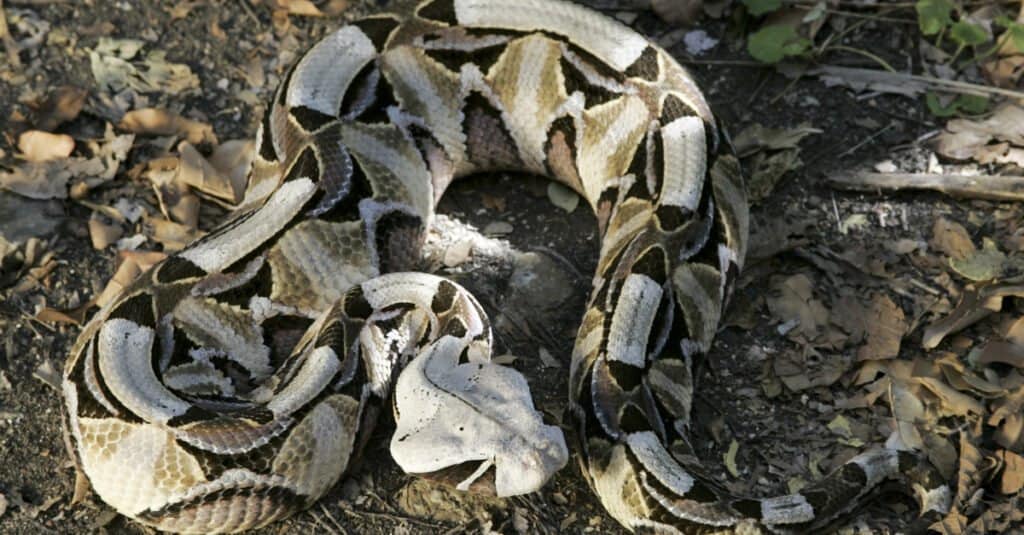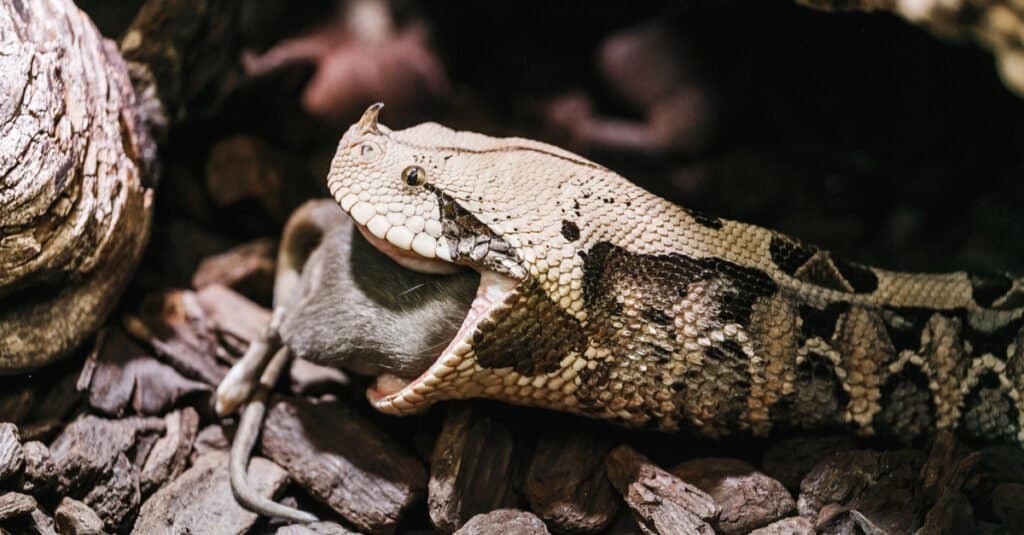Vipers are some of the most venomous snakes on Earth. All vipers are members of the Viperidae family of snakes. They live almost everywhere in the world, except Antarctica, New Zealand, Hawaii, Australia, Ireland, and north of the Arctic Circle. There are many species of viper, but only one of them heralds the largest viper ever recorded.
But a snake doesn’t actually have to have “viper” in its name to be part of the large viper family. Cottonmouths (water moccasins), rattlesnakes, and adders are all members of this venomous family. Vipers range in size from the tiny Namaqua dwarf adder, at only ten inches long, to the largest viper ever recorded.
Here, we’ll learn more about the world’s largest viper. We’ll discuss where these colossal snakes live and whether or not they have venom. Then, we’ll look at the most famous member of the species. Finally, we’ll go over the second-largest viper ever and find out just how big these giant runners-up grow and just what kind of venom they use.
The Largest Viper Ever

Bushmasters are native to South America and are the longest venomous snake in the New World.
©Jim Cumming/Shutterstock.com
The largest species of viper ever recorded is the South American bushmaster (Lachesis muta). These snakes are also known as Atlantic bushmasters.
They’re native to central South America and the island of Trinidad in the Caribbean. Bushmasters live in both old and new-growth forests, as well as near agricultural fields. They prey primarily on rodents, which unfortunately means that they’re sometimes drawn to areas of human activity.
Bushmasters famously rattle their tails, like a rattlesnake, despite their lack of a rattle. They do this as a means of self-defense. Though their tail doesn’t make much noise on its own, when rattled in the leaf litter that bushmasters call home, it makes a loud sound.
This sound serves as a warning to all who come too close — approach and face the bushmaster’s wrath.

How Big Do Bushmaster Snakes Get?

This baby bushmaster is destined to grow nearly 8 feet long!
©Patrick K. Campbell/Shutterstock.com
Bushmasters are the largest vipers ever recorded; they can grow up to 10 feet long. Most bushmasters grow to be between 6.5 and 8 feet long.
The largest bushmaster ever recorded measured a whopping 12 feet long. Bushmasters are the third-largest venomous snakes in the world, behind the black mamba and king cobra. They are also the largest venomous snakes in the Western Hemisphere.
Where Do Bushmaster Snakes Live?
While Bushmaster snakes are considered one of the most aggressive species of snakes on the planet, it is also important to know where they are located so they aren’t disturbed. They live in the forests of Northwestern South America which includes Venezuela, Colombia, Brazil, Ecuador, Peru, and Bolivia.
Are Bushmasters Venomous?

Bushmasters can inject a lethal amount of venom into prey.
©iStock.com/reptiles4all
These South American vipers aren’t just huge; they’re also venomous. All members of the Viperidae family have venom. As the largest viper ever recorded, the bushmaster’s bite can inject a lethal amount of venom. However, bushmasters don’t actively prey on humans.
Instead, they prefer a diet of rats and mice. Bites to humans usually occur by accident (when humans unknowingly step on them) or in cases of self-defense (when humans harass or attempt to handle these deadly snakes).
Lecky: The World’s Most Famous Bushmaster
Back in the 1930s, finding the largest snakes in the world was all the rage. In 1934, a naturalist named Raymond Ditmars brought one of the largest vipers ever recorded to its new home in the Bronx Zoo.
The snake was, in fact, a South American bushmaster Ditmars had named Lecky. Lecky may be the largest viper ever recorded—if reliable measurements existed. As it is, no apparent record of Lecky’s length has survived. But it’s likely that Lecky stretched to around eight feet long.
The Second-Largest Viper Ever

Gaboon vipers spend their lives on the ground; they’re too heavy to climb trees.
©Stu Porter/Shutterstock.com
South American bushmasters may be the largest vipers ever recorded, but they have a close runner-up in the Gaboon viper. Gaboon vipers (Bitis gabonica) live in the forests of sub-Saharan Africa.
They have the distinction of having the longest fangs of any living snake: up to two inches long. Like other vipers, Gaboon vipers use their fangs to incapacitate and kill prey quickly. When they’re not using their fangs, they actually fold them back up into their mouths like switchblade knives.
Gaboon vipers stick to wooded areas, where they blend into the leaf litter. Their scales come in almost every shade of brown and tan to make up intricate patterns that make them almost impossible to see.
To top this camouflage off, their heads are also leaf-shaped, and they have pale tan eyes. Like other vipers, they can sense heat, which means they don’t need sunlight to hunt.
How Big Do Gaboon Vipers Get?
As one of the largest vipers ever recorded, the Gaboon viper grows to lengths of over five feet. That may not sound like much, especially considering that the bushmaster can reach lengths of 12 feet. But, the Gaboon viper’s true size comes from its weight rather than its length.
Gaboon vipers are one of the heaviest pound-for-pound snake species around; a five-foot-long adult can weigh more than 25 pounds. This makes them the heaviest venomous snakes in Africa, even if they aren’t the longest.
Are Gaboon Vipers Venomous?

Gaboon vipers are venomous.
©frantic00/Shutterstock.com
Gaboon vipers have exceptionally long, hollow fangs. The fangs are designed to deliver venom to prey. They’re known as unaggressive snakes but will bite humans if threatened. Most bites occur when people accidentally step on them or try to handle or harass them.
Bites are rarely fatal, thanks to antivenom. But, without immediate treatment with antivenom, bites can result in severe complications and even death. Even more serious, Gaboon vipers tend to hang out to prey, giving them more time to pump even more venom into the wound.
Summary of the Largest Viper Ever Recorded
Here’s a recap of information on the longest viper species on record:
| Habitat of South American Bushmaster: | South American bushmaster (Lachesis muta) |
| Average size of South American Bushmaster: | 6.5-8 feet long |
| Largest South American Bushmaster recorded: | 12 feet long |
| Diet of South American Bushmaster: | Forests of Northwestern South America, including Venezuela, Colombia, Brazil, Ecuador, Peru, and Bolivia |
| Diet of South American Bushmaster: | Rats and mice |
The photo featured at the top of this post is © Jim Cumming/Shutterstock.com
Discover the "Monster" Snake 5X Bigger than an Anaconda
Every day A-Z Animals sends out some of the most incredible facts in the world from our free newsletter. Want to discover the 10 most beautiful snakes in the world, a "snake island" where you're never more than 3 feet from danger, or a "monster" snake 5X larger than an anaconda? Then sign up right now and you'll start receiving our daily newsletter absolutely free.
Thank you for reading! Have some feedback for us? Contact the AZ Animals editorial team.






